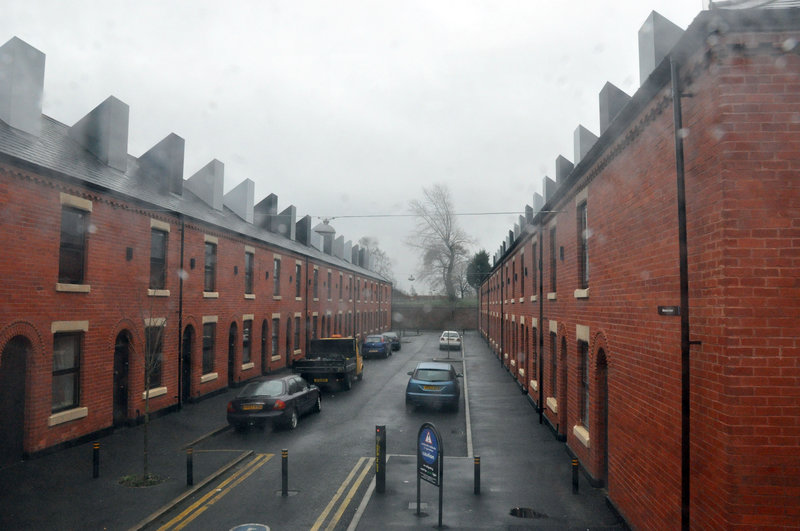Detroit and other Rust Belt cities hoping to reverse decades of decline are finding new inspiration in unexpected places — the older industrial cities of Europe.
In recent weeks, leaders from Detroit, Cleveland and other Midwest cities have traveled to Europe as part of a “Cities in Transition” exchange sponsored by the German Marshall Fund and the Kresge Foundation.
A trip last month took leaders to Leipzig, Germany, and Manchester, England, following an earlier visit to Turin, Italy. All three cities are reversing decades of job losses and population decline.
Whether European success translates to U.S. shores remains to be seen. Among key differences, Europeans tend to accept more government oversight than Americans. A more litigious U.S. society might stymie some of the more freewheeling, entrepreneurial programs Europeans are willing to try.
Even so, the trips have injected a note of excitement into industrial cities’ attempts at reinvention.
“It was an amazing experience to see the past and current differences and similarities,” said Brad Dick, deputy director of general services for Detroit, who visited Leipzig and Manchester. “Ten years from now, we will be showing global cities what Detroit did to change the conversation about us.”
The Spinnerei complex in Leipzig is the sort of urban redevelopment project that makes most American big-city mayors envious.
Spinnerei was once one of Europe’s biggest textile mills, covering three-quarters of a million square feet and employing thousands of workers. The business shuttered in the 1990s when the collapse of communism knocked the props out from under the government-supported firm. Some 90 percent of workers lost their jobs.
Almost immediately, though, artists began moving in, attracted by dirt-cheap costs and the industrial-chic environment. Spinnerei soon was home to hundreds of artists’ studios, a dozen or so galleries, offices for architects, designers, jewelry and fashion producers, a drama workshop, dance center and more. The once-vacant complex is mostly occupied now.
American urban leaders say they particularly admired the strong, unified vision each city fostered in the face of decline.
“Vision leads, really just having a vision that’s out there that’s been bought into by the community,” said Marja Winters, deputy director of Detroit’s Planning and Development Department, who visited Leipzig and Manchester last month. “All the strategy and plans line up.”
Since the mid-’90s, both cities have revitalized their downtown cores as retail, shopping and cultural centers. They have built thousands of new housing units in neighborhoods and boosted new industry, like Manchester’s drive to become a center of digital entertainment technology.
European cities tended to hit bottom at least a decade or more before their American counterparts, and so have been at the game of urban reinvention longer. Mike Emmerich, chief executive of Manchester’s quasi-public Commission for the New Economy, told U.S. visitors, “We’ve been sweating a model of civic entrepreneurship bloody hard for 20 years now.”
One big reason for the comeback is a willingness to let the private sector lead the way. That surprised some Americans used to thinking of Europe as the home of socialistic central planning.
In recent years, Manchester has been remaking its blighted East Manchester district, once home to a heavy concentration of steel, coal mining and other industries. Tellingly, the city has filled redevelopment oversight boards there with people from private industry, not government.
“You can’t stop the market from doing things it wants to do,” said Ian Slater, deputy chief executive of New East Manchester, a quasi-public agency working to develop the district.
Translating these successes to American cities might take some doing, however. For one thing, European policy tends to be more supportive of cities than U.S. policy, which over the decades has encouraged suburban sprawl.
“We definitely try to make people look foolish if they move out of town,” said Oliver Weigel, an official with Germany’s Federal Ministry of Transport, Building and Urban Development.
European cities also take a more integrated approach to revitalization, linking housing, business, education, transit and recreational planning in unified efforts instead of separate silos, as often happens in America. And European policy tends to promote long-term visions and multiyear efforts, while U.S. policy tends to shift with each election cycle.
Alan Mallach, an urban planner based in New Jersey who has studied Detroit and who visited Leipzig and Manchester, said European cities have a clear advantage over U.S. counterparts.
“You’re talking about a way of thinking about how local government operates and makes decisions that is just really, really different from how it’s done” in the U.S., he said.
“The idea that you make decisions for the long haul, that you really make the private sector a full partner in the process, that you have the kind of flexibility that means you can shift gears and do stuff, that’s just a totally different way of thinking.”
Copy the Story Link
Send questions/comments to the editors.



Success. Please wait for the page to reload. If the page does not reload within 5 seconds, please refresh the page.
Enter your email and password to access comments.
Hi, to comment on stories you must . This profile is in addition to your subscription and website login.
Already have a commenting profile? .
Invalid username/password.
Please check your email to confirm and complete your registration.
Only subscribers are eligible to post comments. Please subscribe or login first for digital access. Here’s why.
Use the form below to reset your password. When you've submitted your account email, we will send an email with a reset code.